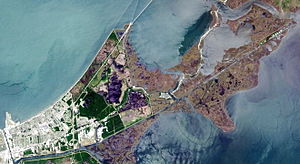
New Orleans East (also referred to as N.O. East and The East) is the eastern section of New Orleans, Louisiana, the newest section of the city. This collection neighborhood sub divisions represents 65% of the city's total land area, but it is geographically isolated from the rest of the city by the Inner Harbor Navigational Canal (Industrial Canal). It is surrounded by water on all sides, bounded by the Industrial Canal, Gulf Intracoastal Waterway, Lake Pontchartrain, Lake Borgne, and the Rigolets, a long deep-water strait connecting the two lakes. Interstate 10 (I-10) splits the area nearly in half, and Chef Menteur Hwy, Downman Rd, Crowder Blvd, Dwyer Rd, Lake Forest Blvd, Read Blvd, Bullard Ave, Michoud Blvd, Hayne Blvd, Morrison Rd, Bundy Rd, and Almonaster Ave serve as major streets and corridors.
As of the 2020 census, the population of eastern New Orleans is 75,223, accounting for 20% of the city’s total population (Table 1). Housing ranges from low-income multifamily apartment complexes and working-class neighborhoods to middle-class single-family subdivisions and affluent, lake-centered gated communities.
Neighborhoods include Pines Village, Plum Orchard, Little Woods, West Lake Forest, Read Boulevard West, Read Boulevard East, Village de L’Est, Venetian Isles, and Lake Catherine (Fig. 2.). Economic drivers in this part of the city include the NASA Michoud Assembly Facility, New Orleans Lakefront Airport, Folgers Coffee Plant, Faubourg Brewing Co., Crescent Crown Distributing, the National Finance Center, and the New Orleans Regional Business Park. A notable characteristic of New Orleans East is its abundance of green spaces, including Bayou Sauvage Urban National Wildlife Refuge, Audubon Louisiana Nature Center, and Joe W. Brown Park.
